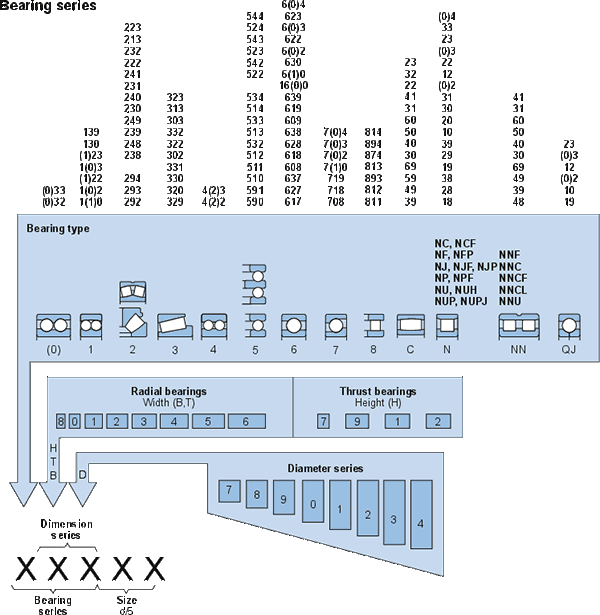The designations of most SKF rolling bearings follow a designation system. The complete SKF bearing designation may consist of a basic designation with or without one or more supplementary prefixes and suffixes. The basic designation identifies:
- the bearing type
- the basic design
- the boundary dimensions
SKF prefixes and suffixes identify design features or bearing components.
SKF bearing designation system

1: Prefixes
2: Basic designation
3: Suffix - Internal design
4: Suffix - External design (seals, snap ring groove, etc.)
5: Suffix - Cage design
6.1: Suffix - Materials, heat treatment
6.2: Suffix - Tolerance, clearance, preload, quiet running
6.3: Suffix - Bearing sets, matched bearings
6.4: Suffix - Stabilization
6.5: Suffix - Lubrication
6.6: Suffix - Other variants
Basic nomenclature of SKF bearings
A basic designation of SKF rolling bearings typically contains three to five digits. please refer to the picture below.

The first digit or letter or combination of letters identifies SKF bearing type and eventually a basic variant.
| Code | SKF bearing type |
|---|---|
| 0 | Double row angular contact ball bearing |
| 1 | Self-aligning ball bearing |
| 2 | Spherical roller bearing, spherical roller thrust bearing |
| 3 | Tapered roller bearing |
| 4 | Double row deep groove ball bearing |
| 5 | Thrust ball bearing |
| 6 | Single row deep groove ball bearing |
| 7 | Single row angular contact ball bearing |
| 8 | Cylindrical roller thrust bearing |
| C | CARB toroidal roller bearing |
| N | Cylindrical roller bearing. Two or more letters are used to identify the number of the rows or the configuration of the flanges, e.g. NJ, NU, NUP, NN, NNU, NNCF |
| QJ | Four-point contact ball bearing |
| T | Tapered roller bearing in accordance with ISO 355 |
The following two digits identify the ISO dimension series. The first digit indicates the width or height series (dimensions B, T or H). The second digit identifies the diameter series (dimension D).
The last two digits of the basic designation identify the size code of the bearing bore. The size code multiplied by 5 gives the bore diameter (d) in mm.
There are some exceptions in SKF basic bearing nomenclature.
- In a few cases the digit for the bearing type or the first digit of the dimension series identification is omitted. These digits are shown in brackets in picture above.
- SKF bearings with a bore diameter of 10, 12, 15 or 17 mm have the following size code identifications:
00 = 10mm
01 = 12mm
02 = 15mm
03 = 17mm - For SKF bearings with a bore diameter < 10 mm, or ≥ 500 mm, the bore diameter is generally given in millimetres (uncoded). The size identification is separated from the rest of the bearing designation by an oblique stroke, e.g. 618/8 (d = 8 mm) or 511/530 (d = 530 mm). This is also true for standard bearings in accordance with ISO 15 that have a bore diameter of 22, 28 or 32 mm, e.g. 62/22 (d = 22 mm).
- For some SKF bearings with a bore diameter < 10 mm, such as deep groove, self-aligning and angular contact ball bearings, the bore diameter is also given in millimetres (uncoded) but is not separated from the series designation by an oblique stroke, e.g. 629 or 129 (d = 9 mm).
- Bore diameters that deviate from the standard bore diameter of a SKF bearing are uncoded and given in millimetres up to three decimal places. This bore diameter identification is part of the basic designation and is separated from the basic designation by an oblique stroke, e.g. 6202/15.875 (d = 15,875 mm = 5/8 in).
SKF bearing series
SKF bearing series designations consist of an identification for the bearing type and the dimension series. The most common series designations are shown in the picture above. The digits in brackets belong to the system, but are not used in the series designation in practice.
SKF bearing prefixes and suffixes
The designations of most SKF rolling bearings follow a system that consists of a basic designation with or without one or more prefixes and/or suffixes
Prefixes and suffixes provide additional information about SKF bearing.
Prefixes
Prefixes are mainly used to identify components of a bearing. They can also identify bearing variants.
Suffixes
Suffixes identify designs or variants, which differ in some way from the original design or from the current basic design. The suffixes are divided into groups. When more than one special feature is to be identified, suffixes are provided in the order.
Some SKF bearing not in the basic designation system
Some SKF bearing are not in the basic designation system, which they can differ significantly from the SKF basic designation system, including:
- Insert bearings
- Needle roller bearings
- Inch tapered roller bearings
- SKF customized bearings
- super precision bearings
- Thin section bearings
- Slewing bearings
- Linear bearings
